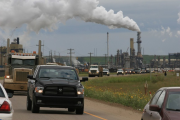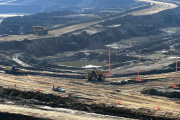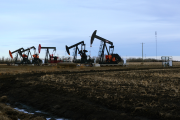By Steven Guilbeault, Co-founder and Deputy Executive Director of Équiterre and Marlo Raynolds, Executive Director of the Pembina Institute.
Earlier this year the Environics Canada World Poll found that global warming and the environment were the world's most pressing issues, according to Canadians.
The in-depth survey of how we see our own place in the world makes it crystal clear that as Canadians we care about the environment: locally, nationally and globally. And we care about how Canada is perceived by people around the world.
While Canadians take pride in having a positive international reputation, this is quickly being tarnished as we become increasingly known for producing "dirty oil" and taking a head-in-the-sand approach to global warming.
Whether strip-mining up to 3,000 square kilometres of boreal forest or drilling an area of Alberta potentially as large as Florida, the environmental impacts of oilsands production are unique in intensity and scale. Oilsands production is a voracious consumer of energy, generating up to five times more greenhouse gas pollution per barrel than conventional oil.
Oilsands operations consume and contaminate large volumes of water. These have already accumulated in toxic tailings lakes covering 50 square kilometres. According to a newly released Pembina Institute report, toxic tailings are produced at a shocking rate of 1.8 billion litres per day. This is more than the total daily water consumption of the entire City of Toronto. Just last month 500 ducks mistakenly landed on toxic tailings lakes and died as a result. Reclamation of these lakes, together with open-pit mines, remains a daunting and unproven experiment.
Threatened Woodland Caribou populations are declining as a result of the web of well pads, roads and pipelines created by "in situ" oilsands drilling operations.
These facts lead to the perfectly reasonable conclusion that, relatively speaking, synthetic crude from the oilsands is "dirty oil." Disappointingly, rather than focusing efforts on cleaning up the oilsands, the federal and Alberta governments are teaming up to convince the world that oilsands aren't so bad, all the while expediting approvals for new oilsands projects.
In an attempt to defend oilsands development, the Government of Alberta has launched a $25 million international public relations campaign, which has been countered by grassroots protestors who want Canada to clean up its poor environmental record. The Government of Canada has been lobbying the United States government to exempt oilsands from a new American law that prohibits government agencies from buying greenhouse gas intensive fuels. Unfortunately for Canadians, these misguided efforts are quite likely to backfire and end up further diminishing our global standing. Quite simply, the facts aren't on Canada's side.
While the rest of the world moves forward in addressing climate change, including our American neighbours, the oilsands are entrenching Canada as the lone laggard on the international stage. Oilsands development currently comprises only four percent of Canada's greenhouse gas emissions, yet its rapid expansion makes it the fastest growing source of global warming pollution. More worrisome, the slowly emerging federal regulations on greenhouse gas pollution are closely modelled on Alberta's weak "intensity-based" approach, requiring only a modest improvement per barrel of production until 2018 at the earliest. With the expected increase in production, federal officials concede that total oilsands pollution will be allowed to nearly triple in the coming decade. If the status quo persists, oilsands production will fundamentally undermine Canada's ability to do its fair share to combat global warming.
The environmental damage that has already occurred as production has grown to more than one million barrels per day has been sufficient to shock the world.
Efforts by the industry to reduce environmental impacts have lagged in comparison to growth in output, and so the situation is actually getting worse, not better. Overcoming this gap will require the use of breakthrough technologies that eliminate greenhouse gas pollution and toxic tailings, reduce or eliminate water requirements, and drastically accelerate reclamation of the land to boreal forest. Until it demands these changes, the federal government will validate and further entrench the world's diminishing view of our country. Today, Canada's citizens, politicians and business leaders are faced with the substantial challenge of reconciling Canadians' concerns for the environment with Canada's poor performance on oilsands and global warming.
Until the federal government's and Alberta's support for oilsands projects is matched by a sincere commitment to address their environmental impacts, Canada will retain the moniker of "dirty oil producer." Even worse, as global critics dig a little deeper, our deceptive public relations efforts to maintain the status quo will put Canada at risk of being permanently branded as an untrustworthy environmental laggard.
Steven Guilbeault, is Co-founder and Deputy Executive Director of Équiterre and Dr. Marlo Raynolds is the Executive Director of the Pembina Institute. Two reports, Fact or Fiction: Oilsands Reclamation and Under-mining the Environment: The Oilsands Report Card, are available for download from www.pembina.org/pubs
- 30 -
759 Words
Contact:
Marlo Raynolds
Pembina Institute
Cell (403) 607-9427
marlor@pembina.org
Marie-Eve Roy
Équiterre
Off (514) 522-2000 Ext. 232
mroy@equiterre.qc.ca
A high resolution copy of the oilsands is available for download at http://gallery.mac.com/pembina_david#100051
[Cutline] Photos of mining are conveniently left out of brochures that attempt to make the oilsands appear environmentally sound. Almost 3,000 square kilometres of Alberta have been leased for mining operations and more than 49,000 square kilometres of 149,000 available have been leased for in situ oilsands operations. Photo: David Dodge.






